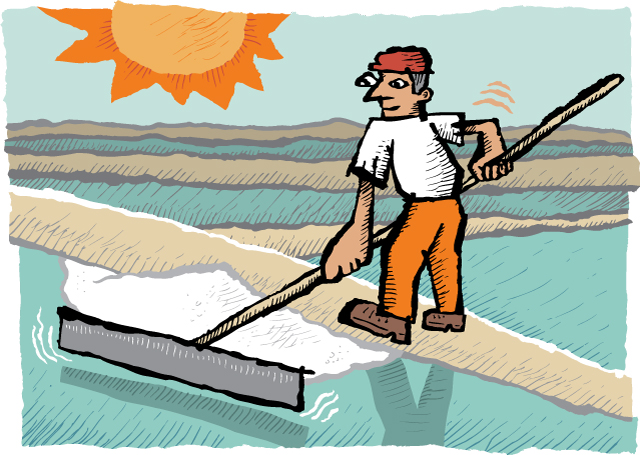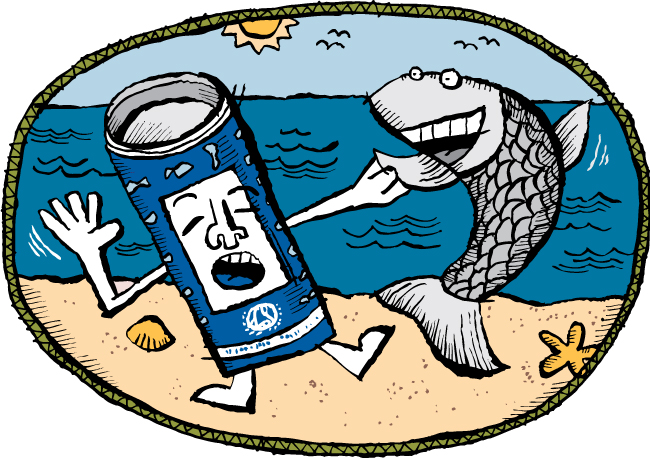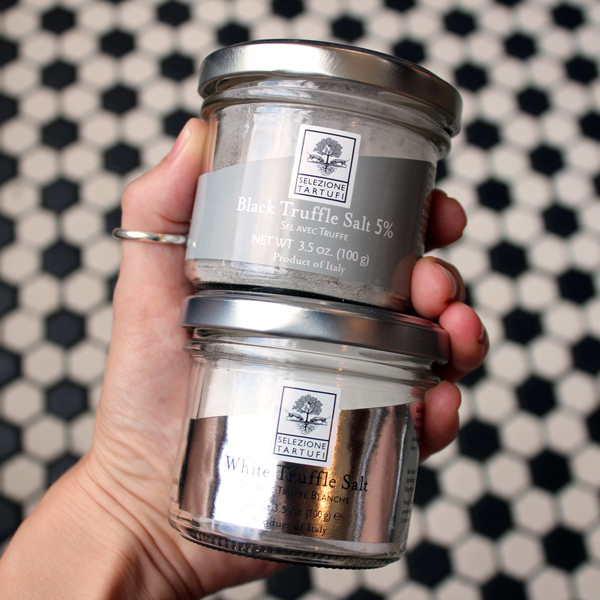By Ari Weinzweig, Zingerman’s Co-Owner & Founding Partner

Each salt has its own distinctive history, flavor, color and texture, all of which I’m eager to learn about and experiment within the kitchen. But while I’m excited for the opportunity experience such a breadth of what’s now on the market, seeing so many special salts reminded to look back to one of the basics of cooking—proper salting of the food we prepare, serve and sell.
I’ve actually had the importance of salting on my mind for a while now. Last year I was attending a culinary conference, where, in a session on barbecue, one of the chefs who presented completely caught my attention: “Hey!” he said, “In my kitchen, I call salt ‘money.’ You can put the best ingredients in the world into your food but if you blow it on the salt the customer’s experience of the dish isn’t going to be very good. . . . three or four cents worth of salt can cost you a lot of money.”
This simple statement was, for me, what we refer to at Zingerman’s as, a “belated glimpse of the obvious.” Because while what he said wasn’t new news in the least, putting it the way that he did got me to thinking about the importance of salt—and the teaching of proper salting of the food—in a more effective light.
Quite simply, I don’t think it’s possible to overstress the import of salt in the professional food world—salt levels can and will completely alter the eating experience of the person who’s consuming what we’re selling. Perfectly salted food is superb. But too much means that the salt will overwhelm everything else in the dish. And undersalting is really almost as bad; an untrained palate eating an undersalted dish will think it’s really not very good. Here are a few real-life experiences that illustrate the point all too (painfully) well.
Story One—Undersalted Soup
I was expediting one night at Zingerman’s Roadhouse—our full service sit-down restaurant—when, within a matter of five minutes we had three comments come in that the Creole Matzoh ball soup we were serving was no good. (If you’re intrigued by the name, the recipe is in Marcie Ferris’ excellent book, “Matzoh Ball Gumbo”). In each case the guests said something along the lines of “the matzo balls were good” but the broth was either “tasteless,” “watery” or “flavorless” (or a combo of all three in one case). This sudden flurry of complaints caught me off guard because we’d been serving the dish for three or four days already and had gotten a lot of compliments on it. And the recipe for the base broth the customers were complaining about is the exact same one we’ve been using at the Deli for over two decades where it’s long been one of our most popular items.
In hindsight the problem started because I’d failed to check the broth in my usual pre-shift quality checking. Unfortunately, neither had anyone else. And together we’d created a problem. When I tasted the broth right after these three complaints came in, I realized immediately why the guests were unhappy—the broth we’d served them hadn’t been salted. See, in order to avoid the problem of broth getting too salty during reheating, we always salt ours when we warm it for service, rather than during the initial cooking. And in this case, the salt had never been added.
The “salt as money” thing couldn’t have been more direct and to the point—the only thing wrong with what we’d served was that it hadn’t had enough salt in it. That everything else was perfect, didn’t much matter. And in the interest of good service, we ended up comping something like five bowls of soup, and I spent a good bit of time talking to the customers as well.
The good news is that I had the chance to demonstrate all this to the guests by simply bringing them a taste of the exact same broth to which we’d added an appropriate amount of salt. And sure enough, with the addition of about six cents worth of salt, their experience of the broth was completely altered. They couldn’t believe how much difference it made. A nice bit of education for them, an expensive lesson for us.
I’m glad to say that this problem isn’t an everyday occurrence. But I can’t tell you that it hasn’t happened before. Lest I thought these problems to happen only to us, I’ve had a similar experience with things being undersalted in many other venues. Not long ago it happened at one of my favorite restaurants, one in which the chef is a friend and the food is pretty consistently excellent. Yet even there, the dish I ordered on this most recent visit came out slightly undersalted. Now because I know cooking and I know the chef and I know the restaurant, I hardly hold this slight slip against anyone, and I simply added salt at the table. But had I not been a food professional, on my first visit to this restaurant, it’s pretty safe to say that I probably would have been underwhelmed by what I was eating, and I might very well have chosen not to return. I’ve experienced the same problem buying breads, baked goods, cheeses and almost everything else you might imagine over the years. A few cents worth of salt would have made all the difference in the world. Bad news for the baker, cook or cheesemaker who worked so long and so hard to get something great out to her customer.
Story Number Two—Oversalted Seafood

Conversely, that very same week as the soup incident we had a piece of prepared-to-order fish on which the line cook got a bit overzealous in his salting. Everything else about the dish was perfect, but excessive salt made the guest’s experience of it rather unpleasant. Again, we refunded money and/or replaced the product. All because we put on about twenty-five grains more sea salt than we should have.
Of course even beyond the financial cost there’s the reality that the guest’s experience of the food was so much less than it could have been. Again, a few pennies worth of salt completely altered the customer’s culinary experience had we not been able to correct the problem quickly in the moment. But it could easily have put poor word of mouth about our food out into the community. And that all the (literally years) of good work to find the raw materials, develop the recipes, train the crew, build the business, etc. was let slip simply by our inappropriate levels of salt.
Start Salting Early On
While this tip is of little help in baking, charcuterie or cheesemaking, in cooking it’s helpful to add salt in small quantities early in the cooking process and then continue to add bits of it as you go. The early addition of salt—say when you start sautéing vegetables for a sauce—draws moisture out early on and helps to blend and concentrate the flavors of what you’re preparing. In the end, you’ll actually use less salt and gain more flavor by taking this approach.)
Getting the Salt Straight
So, what can we all do to help make this salt thing a positive instead of a negative? Here are seven things that are at the top of my list:
- Formal salt training:In order to be successful as a team, it’s imperative that we actually train our staff to taste for salt. That means taking the time to talk about the role that salt plays in cooking. Through a few quick, but important, exercises they can see—I should taste—the difference for themselves. For instance, have staffers taste any item you make but without having added any salt; taste again with the right level of salt; and then again with too much. I can pretty much guarantee that although the actual cost of each of the three versions will be almost identical neither you nor I would be too happy paying top dollar for Options “a” or “c..“ By contrast, Option B, I’ll bet, is well worth whatever we’d have to charge. A few cents of salt too few or too much swings the entire experience of the guest’s eating. And when new staff members taste in this way, I guarantee that the care and attention that they give to salting will be higher. The cost of the training? Far, far less than comping the meals we had to when we didn’t do our salting work properly.
- Calibrate your team’s sense of salt:In the same way that we need to set the standard with service, leadership, or any other issue, we need to set clear expectations about salt. In the same way that we don’t want to leave our organizational definition of great service to the discretion of a new front line staff member, neither do I want to leave the assessment on what the proper level of salting is up to everyone in the business to make on their own. No matter how carefully written our recipes may be, we still need to check salt levels at the end of the cooking to adjust for swings in the impact of cook times, other ingredients, heat levels, etc. And unless there’s agreement on what the “right” level of salt is, we’re going to have wildly different results on different days. Remember this calibration is not an overnight, once-a-decade task—it takes months (if not years) of regular comparative tastings with top team members to get this issue squared away and keep our palates in synch.
- Add the salt at the right time:Remember that the impact salt will have on a dish will vary depending on where in the preparation process we add it. There are times where we want the salt to be a textural component of the dish, or where we like little peaks of salt flavor to hit your tongue as you eat. Fresh mozzarella or bruschetta (Italian garlic bread) come to mind as instances where I want little “salt explosions” to hit your tongue as you eat, so sprinkling on coarse crystals of a great salt right before serving works well. Many of the beautiful salts I saw at the Show would be perfect for this sort of work. (On the other hand, those same specialty salts that might be of particular interest for color or texture will be wasted if they’re added early in the cooking process where they’ll dissolve into the other liquids in the dish.)
In most cooking, we actually want the salt to be even evenly distributed throughout the food, present in the background but not something that should ever catch your attention. And that means that salt has to be added early enough in the cooking process that it will dissolve properly into the liquids in the dish. For this reason, it’s really not OK in my mind to significantly undersalt food in the belief that the customer can just compensate by adding salt at the table. The eating experience of the dish in this latter case will be completely different. Be sure that your staff understands the difference and that we’re adding the salt at the appropriate spot in our preparation.
- Taste everything every day:I don’t really know how else to put this other than any item made from scratch needs to get tasted daily. Of course this is true not just because of the salt. But in the context of this piece, salt levels are our subject at hand and the only way I know to monitor them properly is to taste everything. The salt level could be right on Monday but by the time the item has sat in the steam table or on the shelf or in the case . . . who really knows. Salt levels change as cheese ages, or stocks reduce or as temperatures at which the food is being consumed are varied. Worse still we’ve had a few instances over the years where a baker or cook left the salt out altogether. And the sad reality is that you really can’t “see” an absence of salt—you can only “spot” by putting a small bit of what you’ve prepared into your mouth and assessing it on a batch by batch basis.
- Taste Slowly:One piece of critical salt training is getting our staff to understand that judging salt levels too quickly after tasting is a sure way to get yourself into trouble. To successfully assess saltiness in one’s food, you have to taste slowly; it’s only a minute or two after you’ve put the food in your mouth that you’re going to be able to see how the flavors are coming through. Many times I’ve come oh-so-close to declaring a dish to be “fine,” but fortunately held my tongue long enough to notice that there was actually a bit too much salt in the food.
- If in doubt ASK FOR HELP!This seems simple but because our society generally teaches us NOT to ask for help I think it’s imperative to stress the importance of asking to our crew. Sadly, most new staff members will opt not to “bother” if they’re unsure of themselves and this is especially true with something as mundane as salt levels. But again, because a few cents one way or another, worth of salt can have such a huge impact on the quality of our work, I need to make sure they understand that I want them to ask for a second opinion any time they have even the slightest doubt about salt levels. I need them to understand that proper salting has to come way before our egos, so the default should be to actively find another culinary opinion they respect and have that person taste the dish too.
- Teach salting skills to customers tooAll of this information about salting is really of great value to our customers as well as our staff. We’re selling costly ingredients to people to prepare at home, and poor salting can radically alter their experience of the food they prepare. We can sell them an amazing heirloom potato but if they serve it without enough salt to unlock its flavor they’re likely to think they spent a lot of money for something that will most certainly underwhelm them.
While I can’t imagine that proper salting is something too many of us are naturally passionate about, I hope that this will at least have created a fairly compelling case to approach salt and salting with a higher level of organizational awareness. For a very small proactive investment of time and energy we have the chance to significantly improve the eating experience we offer our customers, build repeat business by serving ever-better tasting food, and reduce the frequency of complaints and the high cost of handling them. And, best of all, we get to invest all those positive returns into in other, far more uplifting areas of work. Like more training, profit sharing, new equipment, or maybe even expanding our inventory of fine sea salts! — ![]()
Salt in History
The current low cost of commercial salt hides its long-standing historical value; what we take totally for granted in the modern world was, for most of human history, a rare and wonderful treasure. Centuries ago table salt was seriously hard to come by. Salt was taken from the sea or the earth with the same passion people might put into panning for gold or searching for silver. There were times in history were salt was traded for more than most precious metals. In fact, the root of the word “salary” is derived from the fact that in Roman times soldiers were paid a special salt allowance, called a salarium, so the idea of calling “salt” “money” is probably more historically oriented than a casual listener to the chef’s speech would have thought.
This search for salt may have been minimized by modern mining techniques but it’s only a catastrophe or two away. Take a look at this:
“For a peasant family, the most vital necessity was salt: not just for cooking, but for the preservation of meat. There were a number of salt-pans on coast, but far too few to satisfy the demand. Some people went down to the sea with cauldrons and tried to make enough by boiling seawater. Many were prepared to walk seventy miles or so each way, to buy salt with money or barter it for flour; a number walked from Aulla over the mountains to Parma when it was rumoured that a consignment had arrived.”
Sound like a centuries-old story from ancient Rome? Try Tuscany in the middle of the 20th century. It’s related by author Kinta Beevor, in her memoir A Tuscan Childhood, telling of the desperate efforts of Italian townspeople to find salt in the months after the end of World War II.



